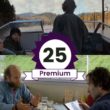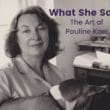Chris Elena’s short film Audio Guide is his best yet, and he made it on film, with no funding. Consider this a guide on how to go out into the great unknown and shoot that short film you’ve always wanted to make.
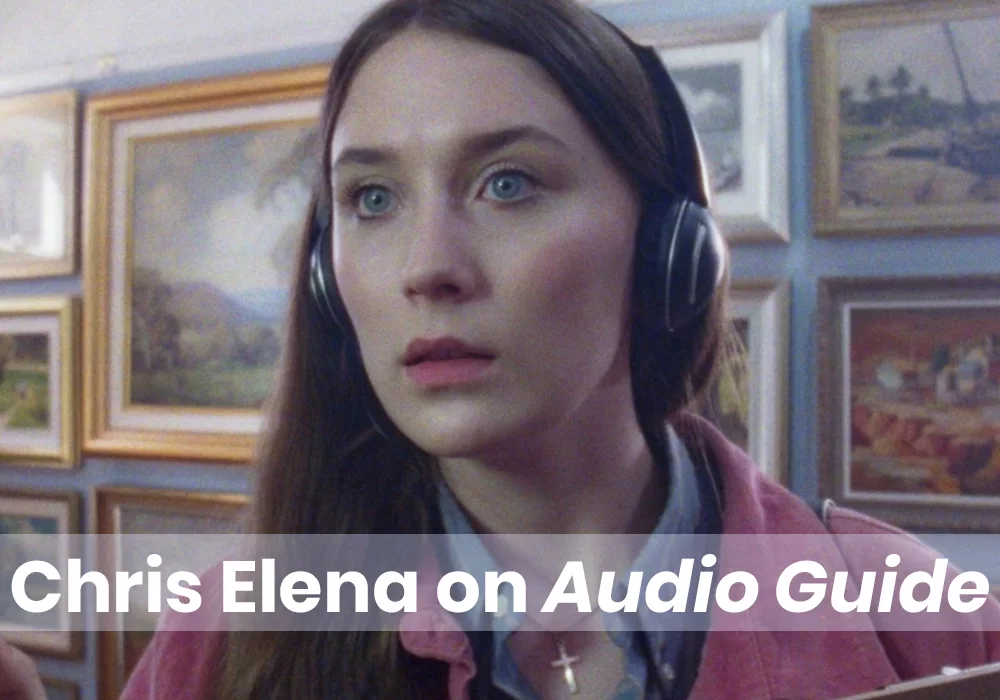
Set in real time as a young art student’s entire perception of reality falls apart, Chris Elena’s short film Audio Guide is a thrilling work of high concept, low budget filmmaking. Audrey (Emma Wright) peruses a small art gallery, pointing her audio guide at various works of art. The regal voice on the device (Nyx Calder) does as it should, for a while, recounting facts about the artworks in the gallery. Everything changes when Audrey points the device at another person, and the voice tells us everything about them, including when and how they will die. Over the next ten minutes, we watch Audrey realise that everything she thought she knew about the world is wrong. She tests the device’s limits, but she’s putting off the ultimate revelation: pointing it at herself.
This interview comes with a disclaimer: the film’s director is a personal friend. It’s been a joy to watch Chris flourish as a filmmaker over the past few years, and Audio Guide is certainly his most accomplished film yet. While I can’t claim impartiality (but I implore you to seek out the short yourself), I can say that getting to speak with Chris in-depth about his filmmaking process was fascinating and invaluable as an aspiring filmmaker myself. How do you make a film when you’ve got no funding, no backing? It’s difficult, sure, but not impossible. How and why do you shoot it on film? None of it is easy, but films made on the creator’s own terms are often the most creative, inspired, and uncompromised. That’s especially true when it comes to the diversity of who we see (or hear) on screen: Chris has expressed a desire to always include trans and non-binary actors in his films, such as the brilliant Nyx Calder who voices the audio guide in this film and starred in Chris’ previous short, Can You Dig It?
Consider this a guide on how to go out into the great unknown and shoot that short film you’ve always wanted to make. It certainly inspired me.
Audio Guide made its World Premiere at the SciFi Film Festival in Australia. It will be touring the film festival circuit over the coming months.
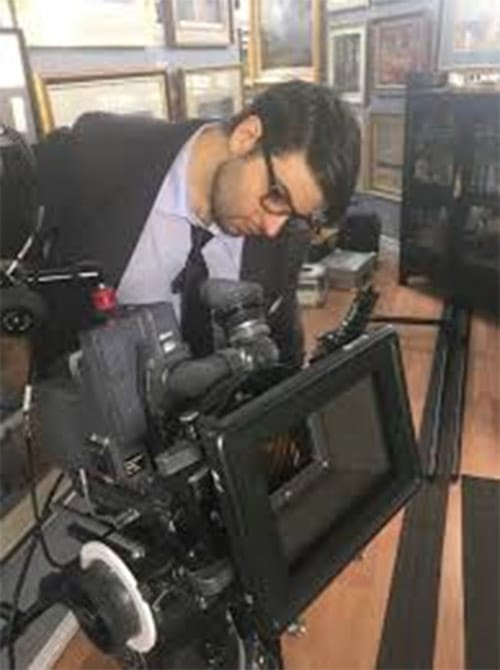
Seventh Row (7R): What was the genesis of Audio Guide?
Chris Elena: I had made two shorts on film, so they were movies that I spent a lot of money, resources, and time on. I took a year or two to make them. The problem with both of them was the writing, and they were scripts that I’d written. I wanted to direct someone else’s writing, and a writer at the time, [Lee Zachariah], had mentioned that he was having writer’s block. I asked him to write me something, and I promised that I would direct it. He said, “What if it’s bad?” I said, “Well… just don’t write something bad!”
I just said, “Come up with whatever you like. If I really dislike it, or I can’t do it, I’ll just tell you.” A few months later, he came up with this. He included a female protagonist, so I’m already interested, because I didn’t want to have a male lead. I always try to stick with female leads. I read it, and I kind of loved it. It felt like it was almost a response to me saying that I over-write and I need to do something not relying on dialogue.
I got the script, and it went on from there. I got excited and spent a year trying to get it made and working on it.
7R: How much did that script change while you were developing Audio Guide?
Chris Elena: It’s pretty similar to the first draft that I got. I told him, “I don’t want to change anything. If I do, I want you to change it, or I’ll talk to you about it.” Changes would mostly be based on restrictions with shooting, because we had no money and no time and locations. It was very kind of him to put five or six locations in there when we had access to none!
I’d asked him to write more character [details], and he refused. I like characters with hearts on their sleeves. I always want emotional stuff; I never want anything to be cold. I wanted more character [details], because [Audio Guide is] just a person running around listening to an iPod and reacting. But he said, “No, you’ve got to find that. I can’t write it. So just work with what you’ve got.” It was a learning curve where I was like, “OK good, I can now work with the actor more and get more out of the performance that’s not on the page.”
Making a short with very few resources
7R: You had very few resources, but you still made Audio Guide! And you made it on film. What was the process of making the film a reality?
Chris Elena: I funded most of it through working full time and saving the money to do it. I realised that nobody else was going to fund it. I did speak to someone about getting funding, even though I try not to because the minute I do that, it’s a month I spend not working towards [making the film]. It’s kind of like I stop in my tracks to go, “Money’s going to come!” It’s not. The one time we looked at funding, I spoke to someone who knew people who could speak to at funding body, but they asked if we could make the character a male protagonist. I said, “Well, that’s never gonna happen, ever, no thank you. I’d rather make it for five dollars.”
I worked full time and came up with most of the money myself. A couple of friends had put in a little money just so we could get across the line, but not much. I went to Kodak and Panavision for the third time [after my previous two short films] and went, “We don’t have much money. I will be forced to go digital if we can’t work out some sort of deal, and I don’t want to do that. I want to keep supporting film and keep getting it out there. What can we do?” I just said it plainly like that, and then they gave me deals. Like they would give me a lens kit and a camera for a small amount, and then they would give me film stock at a somewhat student price because we were working mostly with a student crew. We told the crew that, if they’re working for free, we will overfeed them.
7R: Can you describe the process of location scouting for the film, particularly the museum that the film begins in?
Chris Elena: It was a nightmare! It took six months. Basically we went to museums and they said, “No, get out of here.” I wanted a small gallery. I didn’t want a massive one because that’s less intimate, and it’s more work on the day, which I don’t think we needed.
I found a gallery that focused on Australian artwork, especially Indigenous Aboriginal artwork, so I was excited by that. I wanted that in the background. It was kind of like a small shop space that had been built up to be a gallery, and we used corner shops to make it look a little bit bigger, but still intimate, warm, and kind of claustrophobic, in a weird way.
The alleyway with the big mural was by accident, because one pub said, “Yes you can use our dirty bathroom. We’re not going to clean the floors, but that’s about it.” And I was like, “Oh gee, thanks.” But when we got there, there was graffiti everywhere. I was like, “Oh God, we’re shooting on film. This is perfect!” Our crew thought we were doomed, but I was like, “No no no, it’s film! Every colour will burst. It’ll be magic!” Outside that pub was the mural, and we had no time so we just shot it quickly: got the mural, then got the bathroom.
The church… we lied to get in. When I asked them, they said, “Yep, no problem, come in for three hours. You can shoot.” We got there, and the person who greeted us at the door was a priest, dressed in big lavish priest attire. And I was like, “Oh man, they haven’t asked about the film. This is excellent.” And then as he’s about to close the door, and we’re setting up the camera, he goes, “Oh, what’s the film about?” And I was like, oh no… [because the film depicts God as a fictional creation]. So I lied and said that she’s listening to the voice of God, and he was very happy with that and left us. They had given us four hours, but I insisted we do it in three in case they walk in on us and hear what the film is about.
Working with actors in Audio Guide
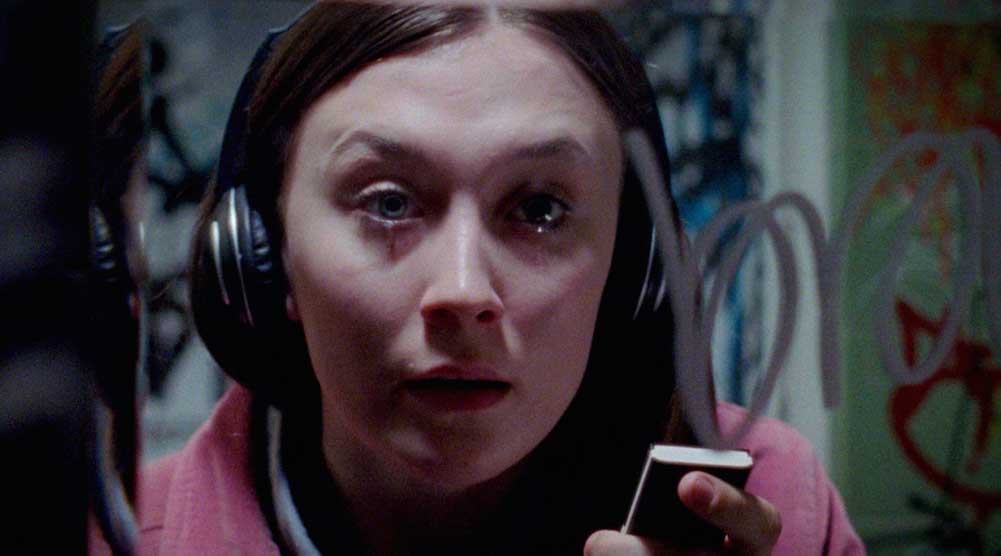
7R: Did you rehearse much?
Chris Elena: Yes. Because we’re shooting on film, we can only get two to three takes of everything, which is how I’ve done [my other films]. I kind of prefer it that way because that means more rehearsal time, which is the best. We did about two to three months [of rehearsal]. Every second or third weekend, we would just meet up and work on reaction and physicality, just talking about how a scene works and why that scene’s there.
7R: The most we learn about the lead character Audrey is at the very end of the film, when she points the audio guide toward herself. Otherwise, we don’t get much backstory or character detail about her. Did you work out a backstory with your actress before shooting?
Chris Elena: I started developing one with Emma just so we had answers to questions when we were making decisions about things she’d do and how she’d react. But the more we started filling in blanks, the more we realised we were just adding blanks for the sake of it. The minute we added more, it was feeling more constructed. That was Emma’s feeling first, and I was like, “Yeah, that’s true.”
7R: Could you talk about working with Nyx Calder, who voices the audio guide, on their voice performance? Especially as what they say gets darker and darker?
Chris Elena: Nyx was in my last film Can You Dig It? I wanted to work with them again. And I wanted to cast Emma [Wright] in the lead, so that was set. I didn’t even audition either of them. I just knew them, and I knew they’d be perfect. Nyx wants to do voice acting, and I said to them that I needed a voice for an audio guide.
I wanted it to sound overly formal. The minute the voice lets up and has any kind of emotional response to what the text is that they’re relaying, even though it’s the voice of a magical device, it has to be subtle. So we went with a very Australian-British formal accent, which if you go to the opera, it’s the voice that you hear as the announcer. And I wanted to try and keep it consistent throughout. So it’s like the voice is a being: they’ll break character little bits here and there, but they stay consistent. That emphasises Emma’s reactions.
We re-recorded it three times: once before the shoot and twice after. It was just a matter of keeping it formal, prim and proper, hoity toity, even though the film is not that.
Sound in Audio Guide
7R: I’m curious about your sound choices in the film, because it’s a film where your main character rarely speaks. It’s all about what she’s hearing. You went with a sparse sound design, the focus being mostly on the voice and the score. How did you decide what we were going to hear?
Chris Elena: It came down to me wanting to make the movie smaller than what its concept suggests. I don’t mind, but people keep calling it like a Black Mirror episode. But a Black Mirror episode emphasises the gimmick or the high concept, and I wanted to go against that. You don’t know how the device works, and it kind of doesn’t matter. It’s more about an individual, how they’re feeling, and the decisions they make once they discover that something’s bigger than them.
I wanted the movie to feel intimate and small, so I did a minimal job with the sound designer. They recorded sound on the day, so they knew everything I was saying to Emma. They were listening, and they said, “Let’s not overthink this; let’s emphasise the soundtrack. Soundtrack will just be an extra aid for your character. Let’s focus more on breathing,” which I was excited about. I wanted to hear breathing and the sound of the wind. Any time there was silence, I wanted it to be really silent. I didn’t want foley to be noticeable. I didn’t want the sounds of anything mechanical or manmade to be in the way. I wanted it to be very organic, natural, but also intimate,quiet, and silent.
Shooting on film
7R: Can you talk a bit about why you love shooting on film so much?
Chris Elena: When you’re directing, it’s up to you to know every decision. Film’s like, “No, you have to have every answer.” You are forced to do [only] two to three takes, but they’re the two to three best takes you’ll do, as opposed to doing digital where you keep looking at it, rewinding, going back… For the actors, as well, it’s good to have those two to three takes [only].
Another thing with film is that everyone works on the same level. With digital, because people have access to look at what you’re shooting, there’s a relaxed sense that we can just do this in post. Film eliminates that. We all have to stop and do the best job ever to get those three takes that are perfect.
I’m going to quote Claire Denis, because she says it better than I ever could: “Digital pushes away; film embraces.” The idea of having something that’s vibrant and beautiful and that looks like a painting shouldn’t be ignored. You know how you’ve got stories where something bad is happening, and it’s all grey… that’s not how things look! Film makes things bigger and grander than they are, which is what a movie should do, in my opinion.
Also, your DP [director of photography] and yourself can work together more, because you need more lights and you need to know where each light’s going because film will pick it up. That’s really exciting.
I’ll add one more justification for shooting on film, if I can. Feeling timeless. An electronic device that can tell the future and reveal the secrets of the past shouldn’t feel modern and clean, like it was made today. I wanted to make something that was old, timeless. People say Black Mirror; I’m kind of leaning more towards The Twilight Zone.
7R: How did you work with your DP [Kym Vaitiekus] to devise the aesthetic of the film?
Chris Elena: Well firstly, another reason we went with film is because of complexions. Film is really good at capturing complexion, and you don’t have to rely on colour grading in post to get there. It has a warm and inviting look that captures skin colour really well.
My DP is also my editor and also partly produced the film. We work together so closely because we’re shooting on film, and because we know each other so well now. Our first approach was closeups. Almost everything is in closeup. I don’t do establishing shots, and I don’t do high angle shots. I kind of hate them for some reason, and I think the reason is we’re usually following someone in a film. You might have a helicopter shot of the entire backyard, but that [character that you’re following] is never going to reach that height. It feels false. Everything I need to know should be in the eyeview of the character.
So it was all about being grounded, focusing on closeups of the person as opposed to objects and the surroundings. But also embracing colour. In colour grading and post-production, we upped the colour as the movie progressed. When things got worse, colour and light started getting louder, as if she’s becoming more sensitive to that. We wanted to focus on that with the lighting, as well.
Moments of comedy in a dark genre film
7R: I’ve got to talk about the bin joke, [where Audrey points the audio guide at a bin, and it just says, very bluntly, “Bin.”]. It’s very funny. It’s a notable point of comedy in a more serious film. Was there much debate about keeping that in and how it affected the tone of the film?
Chris Elena: Honestly, no. We had to re-record that because it wasn’t in the script. There was no bin in the alleyway. And I was just thinking, “This is getting dark: God’s not real, most people die via murder… so why doesn’t the audio guide just read out objects that don’t have a history behind them? Let’s start with bin.” Just the way that sounded, I was just like, “Yes.” They were meant to say, “Bin, Wrapper, This, That.” And I just isolated each one. Bin was just funny. I laughed, and I thought nobody’s going to find that funny; it’s just me being a clown. But then people are going, “The bin joke!” I’m like, “Oh dear, oh no, what have I done!”
